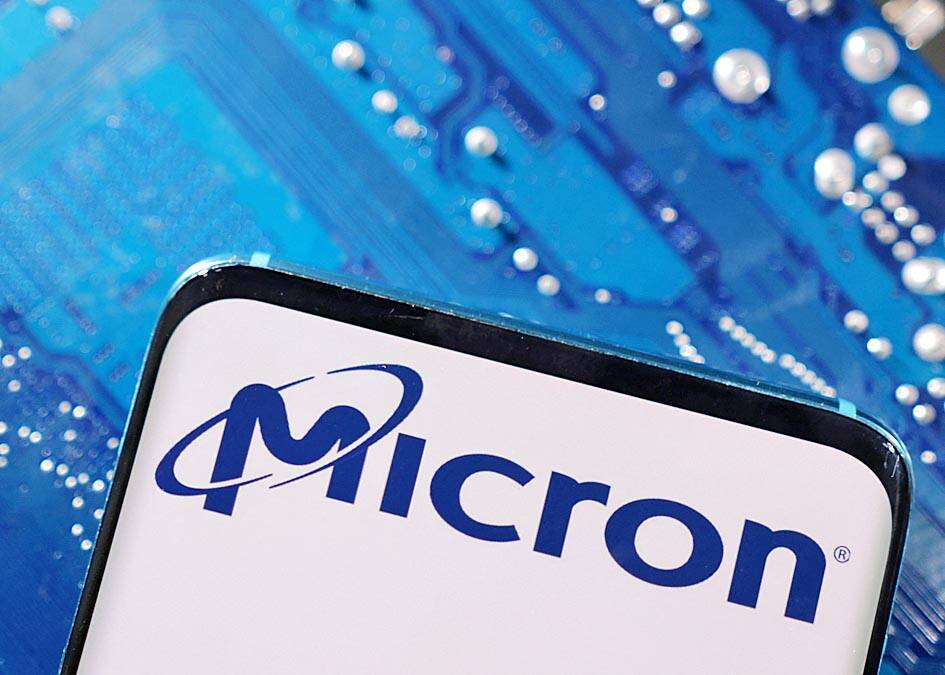US-based memorychip supplier Micron Technology Inc on Friday said that it would start producing its most advanced DRAM exclusively in Taiwan in 2025.
Micron said that it would mass produce chips using its advanced 1-gamma process node DRAM in Taiwan, ahead of any other production site worldwide.
The company installed cutting-edge extreme ultraviolet (EUV) lithography production equipment in its A3 fab in Taichung last year.

Photo: Reuters
The 1-gamma process — its third-generation 10 nanometer-class node — was jointly developed by Micron’s research and development (R&D) teams in Taiwan and Japan.
Micron on Thursday said it would invest up to US$3.6 billion in Japan.
A Ministry of Economic Affairs official said that Micron had informed the ministry of its investment plan in Japan before it was announced.
Micron’s R&D program in Taiwan remains unchanged and would continue as planned, the official said.
The statements from Micron and the ministry apparently aim to ease concerns over the company’s future in Taiwan.
Micron announced its Japanese investment plan after Japanese Prime Minister Fumio Kishida met with executives from seven semiconductor companies, including Micron and Taiwan Semiconductor Manufacturing Co (台積電). The others were Applied Materials Inc, IBM Corp, Samsung Electronics Co, Intel Corp and Belgian semiconductor research group Interuniversity Microelectronics Centre.
The plan would include additional investment over the next few years in Micron’s factory in Hiroshima Prefecture, the company said.
According to a report from Nikkei Asia, the Hiroshima plant produces advanced DRAM chips and the US chipmaker plans to install a state-of-the-art production line there, with Tokyo’s backing.
That could include EUV lithography production equipment, needed for the mass production of the 1-gamma process, which Micron said it would install in Japan, without specifying whether it would be used at the Hiroshima facility.
EUV refers to a soft X-ray technology, which has a wavelength of 13.5 nanometers.
Micron is the largest foreign employer and foreign direct investor in Taiwan, with more than 10,000 workers in its fabs in Taichung and Taoyuan.
Micron has said it would continue to recruit highly skilled personnel in the years ahead.
The Taoyuan factory is from Micron’s acquisition of Taiwanese DRAM maker Inotera Memories Inc (華亞科技) in 2016, while the Taichung factory is from the acquisition of another local DRAM maker, Rexchip Electronics Corp (瑞晶電子), in 2012.

CHIP RACE: Three years of overbroad export controls drove foreign competitors to pursue their own AI chips, and ‘cost US taxpayers billions of dollars,’ Nvidia said China has figured out the US strategy for allowing it to buy Nvidia Corp’s H200s and is rejecting the artificial intelligence (AI) chip in favor of domestically developed semiconductors, White House AI adviser David Sacks said, citing news reports. US President Donald Trump on Monday said that he would allow shipments of Nvidia’s H200 chips to China, part of an administration effort backed by Sacks to challenge Chinese tech champions such as Huawei Technologies Co (華為) by bringing US competition to their home market. On Friday, Sacks signaled that he was uncertain about whether that approach would work. “They’re rejecting our chips,” Sacks

It is challenging to build infrastructure in much of Europe. Constrained budgets and polarized politics tend to undermine long-term projects, forcing officials to react to emergencies rather than plan for the future. Not in Austria. Today, the country is to officially open its Koralmbahn tunnel, the 5.9 billion euro (US$6.9 billion) centerpiece of a groundbreaking new railway that will eventually run from Poland’s Baltic coast to the Adriatic Sea, transforming travel within Austria and positioning the Alpine nation at the forefront of logistics in Europe. “It is Austria’s biggest socio-economic experiment in over a century,” said Eric Kirschner, an economist at Graz-based Joanneum

BUBBLE? Only a handful of companies are seeing rapid revenue growth and higher valuations, and it is not enough to call the AI trend a transformation, an analyst said Artificial intelligence (AI) is entering a more challenging phase next year as companies move beyond experimentation and begin demanding clear financial returns from a technology that has delivered big gains to only a small group of early adopters, PricewaterhouseCoopers (PwC) Taiwan said yesterday. Most organizations have been able to justify AI investments through cost recovery or modest efficiency gains, but few have achieved meaningful revenue growth or long-term competitive advantage, the consultancy said in its 2026 AI Business Predictions report. This growing performance gap is forcing executives to reconsider how AI is deployed across their organizations, it said. “Many companies

Taiwan’s long-term economic competitiveness will hinge not only on national champions like Taiwan Semiconductor Manufacturing Co. (TSMC, 台積電) but also on the widespread adoption of artificial intelligence (AI) and other emerging technologies, a US-based scholar has said. At a lecture in Taipei on Tuesday, Jeffrey Ding, assistant professor of political science at the George Washington University and author of "Technology and the Rise of Great Powers," argued that historical experience shows that general-purpose technologies (GPTs) — such as electricity, computers and now AI — shape long-term economic advantages through their diffusion across the broader economy. "What really matters is not who pioneers